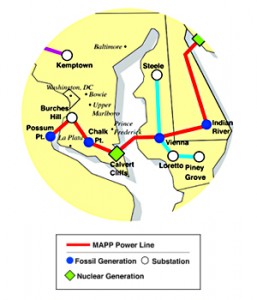PJM & PEPCO’s MAPP line trying to appease
May 9th, 2010
The MAPP line, PEPCO’s Mid-Atlantic Power Pathway transmission line project through Maryland and Delaware, is in the news again. But why??? Where the line is not needed, and it’s withdrawn by PJM and PEPCO, why is this being accepted? Why is this regarded as a “win?”
Remember that they pulled the project?
PEPCO letter 1.8.09 to suspend MAPP, includes 1.8.09 letter from PJM’s Herling
And before that, the part from Indian River to Salem was eliminated?
The May, 2009, Press Release says:
According to Gausman, PJM has also reviewed the need for the section of the line that would run from Delmarva Power’s Indian River substation near Millsboro, Del., to Salem, N.J., and has decided to move this portion of the line into its “continuing study” category. This means that the reconfigured MAPP line will now extend approximately 150 miles from northern Virginia, across southern Maryland and the Chesapeake Bay, and terminate at Indian River. The change would likely reduce the total project cost from $1.4 billion to $1.2 billion.
And then there’s the report that shows there’s no need, that demand is downdowndown, that “congestion” is downdowndown, that price of electricity is downdowndown, that demonstrates that the market concept that they’re all drooling over will have them aspirating their aspirations:
So then why did they send out a press release last week:
…which every Peninsula news outlet gave pretty much verbatim coverage?
And then there’s the PJM RTEP 2009, released February 26, 2010.
So here’s how their press release looks after the papers get it:
Delaware utilities: Plan takes power line under Choptank
It is being planned by Pepco Holdings Inc., parent company of Delmarva.
Now read the other “articles” and tell me if there’s an echo in the room:
Underwater power line route suggested
Proposal under Chesapeake avoids refuge
By Calum McKinney • Staff Writer • May 6, 2010
But the day before it was better, with some original quotes:
Sussex County ponders Power Pathway
November 3rd, 2009
Sussex County has held off on taking a formal stand on Delmarva Power’s Mid-Atlantic Power Pathway, or MAPP, but Delmarva is pushing, so now’s the time to call them with a simple message:
No, don’t encourage and facilitate coal!
Say NO! to Delmarva Power’s Mid-Atlantic Power Path transmission proposal!
Delmarva Power is going around drumming up support for its Mid-Atlantic Power Pathway, or MAPP. They approached Sussex County to support the line (what do we know about that? Not much. Perhaps a FOIA to see what they’ve been doing is in order?) and because there’s a zoning matter before the County, they held off..
Delaware Electric Coop would like to use the MAPP line to bring in electricity from a new Old Dominion coal plant in Virginia. Oh… great idea… I’ve posted about this before:
Here’s Alan’s Green Delaware Alert and handout for DEC’s last annual meeting:
Building a coal plant is a really bad idea, and building transmission for coal is a really bad idea plus… two wrongs do not make a right.
Call all the County Council, thank them for putting on the brakes, and let them know what you think about Delmarva Power’s transmission for coal:
Michael H. Vincent (302) 629-2396
Samuel R. Wilson (302) 856-2972
Joan R. Deaver (302) 645-6657
George B. Cole (302) 539-1611
Vance C. Phillips (302) 542-1501
Here’s a report from the Cape Gazette:
Sussex County council delays support of transmission line
Pathway could pump $260 million in county’s economy
Moore responded with an emphatic yes.
He said anticipated savings are about 60 cents per month in charges related to congestion.
